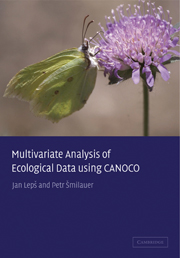Book contents
- Frontmatter
- Contents
- Preface
- 1 Introduction and data manipulation
- 2 Experimental design
- 3 Basics of gradient analysis
- 4 Using the Canoco for Windows 4.5 package
- 5 Constrained ordination and permutation tests
- 6 Similarity measures
- 7 Classification methods
- 8 Regression methods
- 9 Advanced use of ordination
- 10 Visualizing multivariate data
- 11 Case study 1: Variation in forest bird assemblages
- 12 Case study 2: Search for community composition patterns and their environmental correlates: vegetation of spring meadows
- 13 Case study 3: Separating the effects of explanatory variables
- 14 Case study 4: Evaluation of experiments in randomized complete blocks
- 15 Case study 5: Analysis of repeated observations of species composition from a factorial experiment
- 16 Case study 6: Hierarchical analysis of crayfish community variation
- 17 Case study 7: Differentiating two species and their hybrids with discriminant analysis
- Appendix A Sample datasets and projects
- Appendix B Vocabulary
- Appendix C Overview of available software
- References
- Index
17 - Case study 7: Differentiating two species and their hybrids with discriminant analysis
Published online by Cambridge University Press: 09 February 2010
- Frontmatter
- Contents
- Preface
- 1 Introduction and data manipulation
- 2 Experimental design
- 3 Basics of gradient analysis
- 4 Using the Canoco for Windows 4.5 package
- 5 Constrained ordination and permutation tests
- 6 Similarity measures
- 7 Classification methods
- 8 Regression methods
- 9 Advanced use of ordination
- 10 Visualizing multivariate data
- 11 Case study 1: Variation in forest bird assemblages
- 12 Case study 2: Search for community composition patterns and their environmental correlates: vegetation of spring meadows
- 13 Case study 3: Separating the effects of explanatory variables
- 14 Case study 4: Evaluation of experiments in randomized complete blocks
- 15 Case study 5: Analysis of repeated observations of species composition from a factorial experiment
- 16 Case study 6: Hierarchical analysis of crayfish community variation
- 17 Case study 7: Differentiating two species and their hybrids with discriminant analysis
- Appendix A Sample datasets and projects
- Appendix B Vocabulary
- Appendix C Overview of available software
- References
- Index
Summary
While we can think of potential applications for linear discriminant analysis (LDA) in ecology (such as finding differences in habitat conditions among a priori recognized community types), its real use is quite infrequent. This is probably caused by the fact that many problems that seem to be a good fit for discriminant analysis produce weak rather than convincing results. A good example of this might be an attempt to use discriminant analysis for the selection of plant species indicating a particular community type. The discriminant analysis then attempts to separate the community types using a linear combination of species abundances. However, because the species occurrences are often strongly correlated and each of them alone provides little information, it is usually impossible to single out few such diagnostic species, even if the species composition differs strongly among the distinguished types. We will therefore use an example from a numerical taxonomy here, in the hope that the topic will be easily understood by ecologists and that they can apply the hints provided to their own problems.
Data
The sample data were taken from a taxonomic study of several species of Melampyrum, hemiparasitic plants from the Scrophulariaceae family. Eighty plant specimens were measured, selected from four taxonomic groups: M. bohemicum from Czech localities, M. bohemicum from Austrian localities, hybrid populations of M. bohemicum × M. nemorosum, and M. nemorosum. Each group was represented by 20 specimens, originating usually from several local populations. You will be looking for the plant vegetative and flower-related characteristics, which would allow the four taxonomic groups to be distinguished.
- Type
- Chapter
- Information
- Multivariate Analysis of Ecological Data using CANOCO , pp. 245 - 252Publisher: Cambridge University PressPrint publication year: 2003



